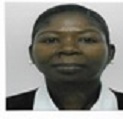
Mary Anti Chama
University of Ghana, Ghana
Title: Antibacteria, antiparasitic and in silico studies of dichapetalum madagascariense Poire
Biography
Biography: Mary Anti Chama
Abstract
Dichapetalum madagascariense (Dichapetalaceae) is used to treat bacterial infections, jaundice, urethritis and viral hepatitis. Its root has been investigated to contain broad spectrum biologically active dichapetalins. To evaluate the plant’s antibacterial and antiparasitic potentials coupled with in silico methods, we isolated and identified the known dichapetalins A and M from the roots. Both dichapetalins were tested together with the leaf (DML) and root (DMR) ethanol extracts on six ATCC bacteria strains (Shigella flexneri, Bacillus cereus, Salmonella paratyphi B, Listeria monocytogenes, Escherichia coli, Staphylococcus aureus) and three parasites; Trypanosoma brucei brucei, Leishmania donovani and Plasmodium falciparum 3D7 strain using the Alamar Blue Assay. Dichapetalins A and M were potent against B. cereus with IC50, 11.15 and 3.15 µg/ml respectively compared with ampicillin (IC50, 1.70 µg/ml). DML (IC50, 0.45 µg/ml) was threefold more potent than ampicillin (IC50, 1.5 µg/ml) against S. paratyphi B and more active (IC50, 12.65 µg/ml) against S. flexneri than ampicillin (IC50, 14.02 µg/ml). Dichapetalins A (IC50, 74.22 µg/ml) and M (IC50, 72.34 µg/ml) were only active against T. b. brucei compared to the standard extract of Coptis japonica (IC50, 3.6 µg/ml) and suramin (IC50, 4.96 µg/ml). Dichapetalin M showed moderate activity against L. donovani (IC50, 0.21 µg/ml) with IC50, 16.80 µg/ml. DML and DMR gave IC50, 9.66 and 11.17 µg/ml respectively against T. b. brucei when compared with C. japonica (IC50, 3.6 µg/ml) and suramin (IC50, 4.96 µg/ml). Target prediction with PIDGIN software indicated NR1I2 as a plausible target for dichapetalin A. Protein BLASTing the protein sequence of this xenobiotic sensor nuclear receptor to the used species suggested that dichapetalin A may have a bacteriostatic effect through the nucleotide hydrolase NUDIX (T. brucei), or the uncharacterised protein YagA or ydbH (S. flexneri). However, the understanding of the exact mechanism of the dichapetalin’s antibiotic effect requires further research.

